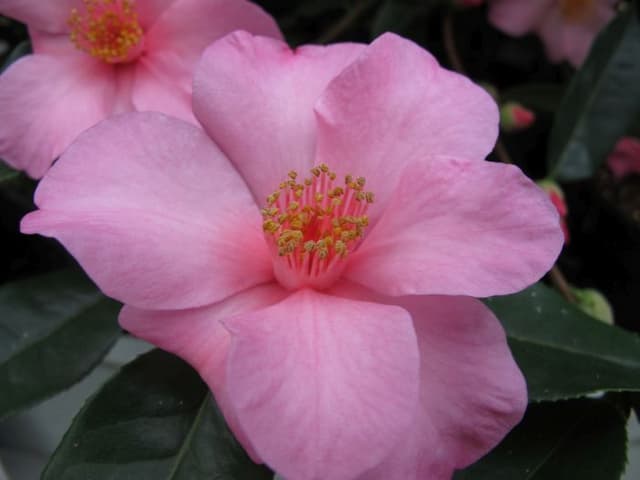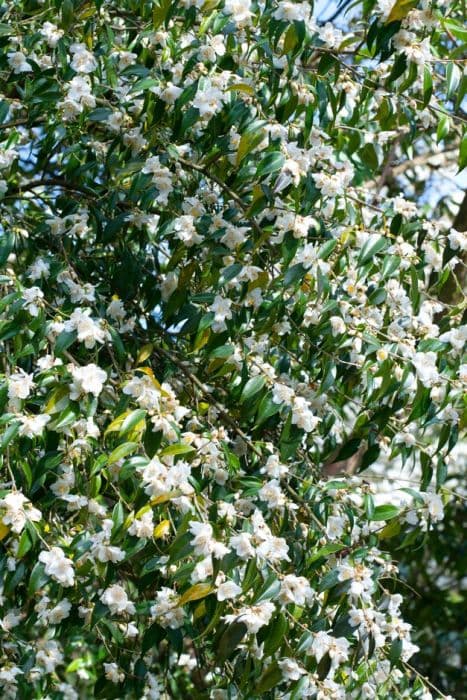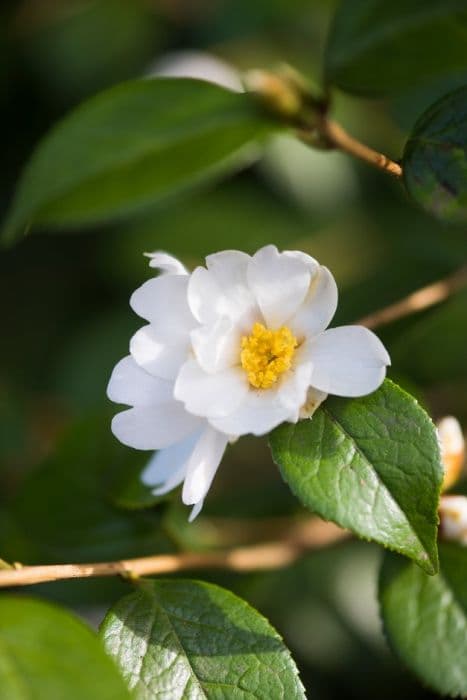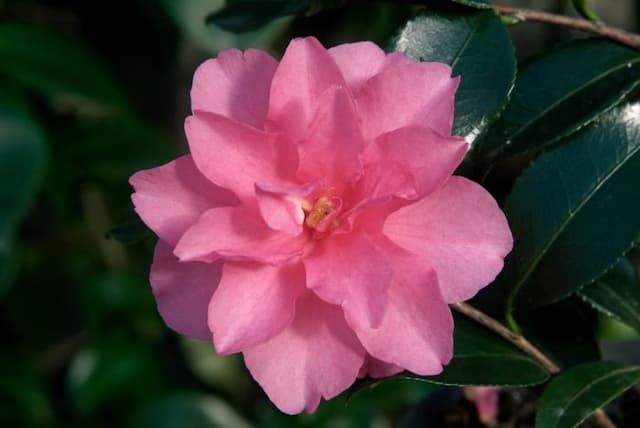Japanese camellia Camellia japonica 'Bokuhan'

ABOUT
The Camellia japonica 'Bokuhan', commonly referred to as the Japanese camellia, is a captivating plant that boasts stunning flowers and lush foliage. It is cherished for its large, showy blooms that offer a magnificent display of color and texture. The flowers exhibit a deep, velvety red hue with petals that can appear almost waxy. Their form is typically semi-double, meaning that they have two or more rows of broad petals with a conspicuous tuft of intermingled petaloids and stamens at the center. This creates an elegant ruffled look which is further accentuated by the contrast between the dark petals and the bright yellow stamens. The leaves are a glossy, rich green that provide a perfect backdrop to the flowers. They are leathery to the touch and have a slightly serrated edge which adds to the textural interest of the plant. The foliage is evergreen, providing year-round interest even when the plant is not in flower. The Japanese camellia has a natural bushy and dense growth habit, which contributes to its attractiveness as an ornamental plant in many garden settings. In summary, the Japanese camellia is a captivating ornamental plant with rich, red semi-double flowers and attractive dark green foliage, offering a striking presence that becomes a focal point in any garden.
About this plant
 Names
NamesFamily
Theaceae.
Synonyms
Japanese Camellia, Camellia, Japonica.
Common names
Camellia japonica 'Bokuhan'.
 Toxicity
ToxicityTo humans
The common name for Camellia japonica 'Bokuhan' is Japanese camellia. Japanese camellia is not considered toxic to humans. There are no well-documented cases of poisoning from ingesting this plant, and it is generally regarded as safe. Therefore, accidental ingestion is not likely to result in adverse symptoms.
To pets
The common name for Camellia japonica 'Bokuhan' is Japanese camellia. Japanese camellia is also generally considered non-toxic to pets such as dogs and cats. It is not known to contain any substances that are poisonous to pets, so ingestion should not result in significant symptoms of toxicity or serious consequences. However, as with the consumption of any non-food item, gastrointestinal upset is possible if a pet consumes large quantities of the plant.
 Characteristics
CharacteristicsLife cycle
Perennials
Foliage type
Evergreen
Color of leaves
Green
Flower color
Pink
Height
6-10 feet (1.8-3 m)
Spread
5-7 feet (1.5-2.1 m)
Plant type
Shrub
Hardiness zones
7
Native area
Japan
Benefits
 General Benefits
General Benefits- Aesthetic Appeal: The Camellia japonica 'Bokuhan' features beautiful, large flowers that add color and visual interest to gardens and landscapes.
- Year-Round Interest: With glossy evergreen leaves, this camellia provides a backdrop of green throughout the year, even when not in bloom.
- Shade Tolerance: It can grow well in partially shaded areas, making it suitable for planting under taller trees or on the north side of buildings.
- Privacy Screening: Due to its dense growth habit, it can be used to create a living privacy screen or hedge.
- Versatility in Landscaping: This plant can be used in various landscape designs, including formal, woodland, and Asian-themed gardens.
- Wildlife Support: Its flowers can provide nectar for pollinators such as bees and butterflies, supporting local ecosystems.
- Low Maintenance: Once established, they require minimal care, making them ideal for those who want a beautiful garden without a lot of work.
- Soil Improvement: Falling leaves and petals can contribute to soil health by decomposing and adding organic matter.
 Medical Properties
Medical Properties- This plant is not used for medical purposes.
 Air-purifying Qualities
Air-purifying QualitiesThis plant is not specifically known for air purifying qualities.
 Other Uses
Other Uses- Crafting plant-based dyes: The petals of the Camellia japonica 'Bokuhan' can be used to create natural dyes for textiles, giving fabrics a unique and subtle color.
- Insecticide: The leaves of the Camellia can be infused into water to create a natural insecticide spray for protecting other plants in the garden.
- Offering for ceremonies: Particularly in East Asian cultures, the blossoms might be used in traditional ceremonies or as offerings at temples due to their beauty and cultural significance.
- Botanical art: The distinct flowers of the Camellia are commonly used as subjects in botanical art, illustrations, and photography.
- Composting: Fallen Camellia flowers and leaves can be added to compost bins as a source of organic matter, helping to enrich soil.
- Educational tool: The Camellia is utilized in educational settings, such as botanical gardens or horticultural classes, to teach about plant biology and taxonomy.
- Cultural icon: The Camellia sometimes features in literature and films as a symbol of love, purity, or the transient nature of life.
- Flower arranging: Camellia flowers are popular in ikebana, the Japanese art of flower arranging, due to their form and long-lasting qualities.
- Surface cleaner: The acidic properties of some parts of the plant can be used in preparing homemade, plant-based cleaners for surfaces like glass and metal.
- Decoration: The waxy, bright green leaves of the Camellia can serve as a long-lasting backdrop or filler in decorative bouquets and arrangements.
Interesting Facts
 Feng Shui
Feng ShuiCamellia is not used in Feng Shui practice.
 Zodiac Sign Compitability
Zodiac Sign CompitabilityCamellia is not used in astrology practice.
 Plant Symbolism
Plant Symbolism- Love - In many cultures, the Camellia represents love and affection, with Bokuhan's richly colored flowers often symbolizing deep desire and passion.
- Admiration - The perfectly formed petals of the Camellia express admiration for someone's accomplishments and perfections.
- Perfection - Camellias are associated with the ideal, symbolizing the pursuit of excellence and flawlessness.
- Longevity - Camellias are evergreen and long-lived, making them a symbol of eternal life or a long-lasting relationship.
- Devotion - Often given as a gift, a Camellia signifies the giver's sincere devotion toward the receiver.
 Water
WaterJapanese Camellia should be watered deeply to ensure the roots can access moisture; aim for about 1-1.5 inches of water per week, depending on the weather and soil conditions. During active growth in spring and summer, water this plant more frequently, about twice a week, tapering off to once a week or less often during the fall and winter months. The soil should be kept moist but not waterlogged; if your camellia is potted, ensure that excess water can drain away easily. Water the plant slowly at the base to minimize water on the leaves and flowers, which can encourage fungal diseases. It is best to use around a gallon of water at each watering session, adjusting for the size of the plant and the temperature, as hotter temperatures may require additional water.
 Light
LightJapanese Camellias thrive in partial shade to filtered sunlight; direct afternoon sun can be too intense and may cause leaf scorch. The best spot for these plants is where they can receive morning sunlight and afternoon shade, especially in the warmer months. When placing them indoors, a bright room with indirect light is ideal, avoiding too much direct sun through windows.
 Temperature
TemperatureJapanese Camellias prefer a temperate climate and can thrive in temperatures that regular between 50°F and 60°F. However, they can tolerate minimum temperatures down to around 20°F for short periods, but frost can damage the flower buds and flowers. In the summertime, they can handle temperatures up to about 80°F, but it's important to protect them from intense heat by providing ample shade.
 Pruning
PruningPrune Japanese Camellias in spring after blooming ends to maintain shape and encourage bushier growth. Remove any dead or crossing branches to promote good air circulation, which is essential to prevent disease. Light pruning can be done every year, but more extensive pruning should be carried out every few years to rejuvenate older plants.
 Cleaning
CleaningAs needed
 Soil
SoilThe best soil mix for a Japanese Camellia (Camellia japonica 'Bokuhan') is well-draining and rich in organic matter, such as a mix of 1/3 pine bark, 1/3 peat moss, and 1/3 perlite or sand. The soil pH should be slightly acidic, ideally between 5.5 and 6.5, to allow for optimal growth and nutrient uptake.
 Repotting
RepottingJapanese Camellias should be repotted every 2 to 3 years to ensure they have enough room to grow and to refresh the soil. It's best done in late winter or early spring before the growing season starts, taking care not to damage the delicate roots during the process.
 Humidity & Misting
Humidity & MistingJapanese Camellias thrive in environments with moderate to high humidity levels; ideally, the humidity should be maintained at around 40-50%. These plants can suffer in dry indoor air, so it may be necessary to use a humidifier or place a humidity tray near the plant to maintain optimal conditions.
 Suitable locations
Suitable locationsIndoor
Provide bright, indirect light and monitor humidity.
Outdoor
Shelter from harsh sun, well-drained soil, and protect from frost.
Hardiness zone
7-9 USDA
 Life cycle
Life cycleCamellia japonica 'Bokuhan', commonly known as the Japanese camellia, begins its life as a seed which germinates in conducive soil temperature and humidity. Upon germination, the seedling emerges, establishing a root system and producing its first leaves. As it enters the vegetative growth stage, it develops a woody stem and foliage, eventually becoming a mature shrub. The plant then enters the reproductive phase, characterized by the development of buds that bloom into the characteristic large, showy flowers, usually in late winter to spring. After pollination, fertilized flowers produce seeds, completing the life cycle. Throughout its life, which can span several decades, the plant will undergo periods of growth and dormancy, typically aligning with seasonal changes.
 Propogation
PropogationPropogation time
Spring-Early Summer
The most popular method of propagating Camellia japonica 'Bokuhan', also known as the Japanese camellia, is through semi-hardwood cuttings. This technique is typically done during the late summer, when the current year's growth begins to harden. Gardeners select healthy, disease-free branches and cut a 4 to 6-inch long piece (10 to 15 centimeters) just below a leaf node. The leaves at the lower end are removed, and the cut end may be dipped in rooting hormone to enhance root development. Then, the cutting is inserted into a well-draining potting mix and kept in a humid environment with indirect sunlight. With consistent moisture and warmth, roots usually form within a few months, and the new plants can be gradually introduced to outdoor conditions the following spring.









